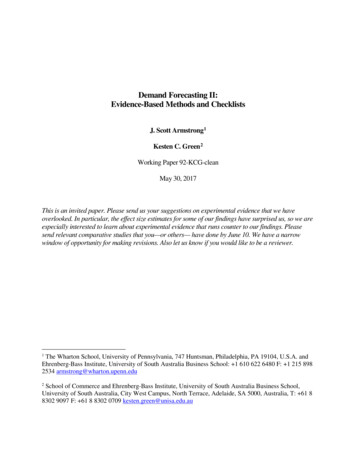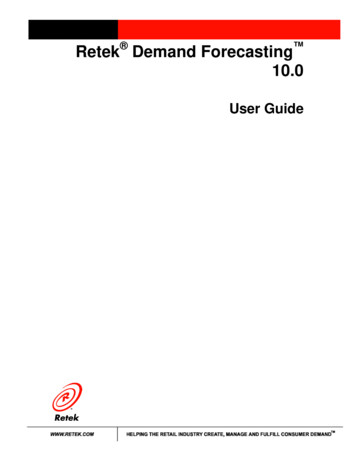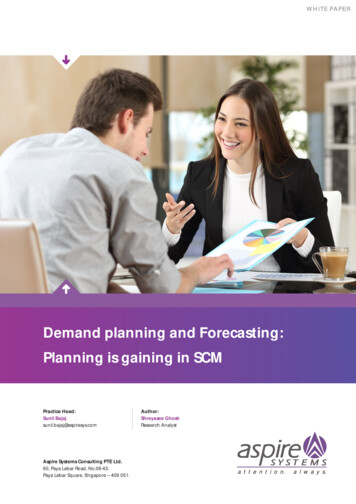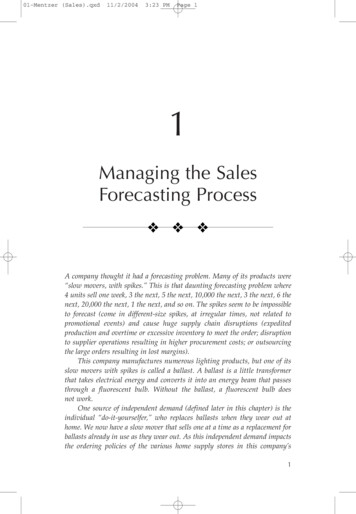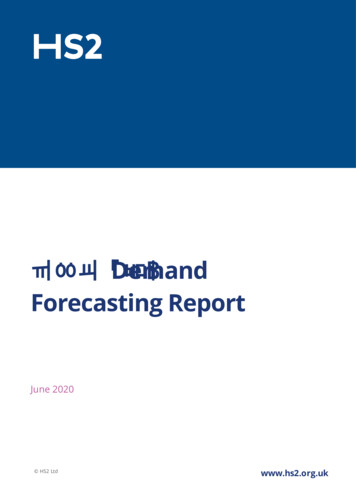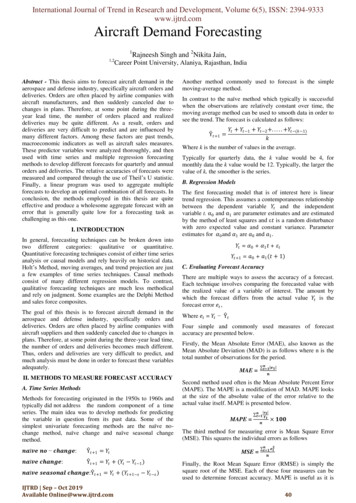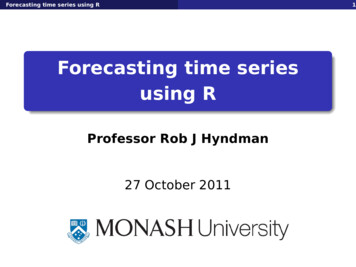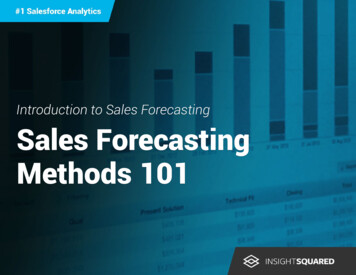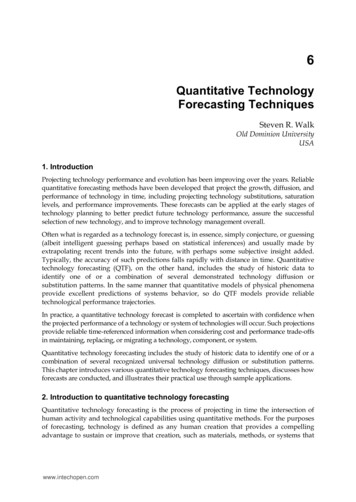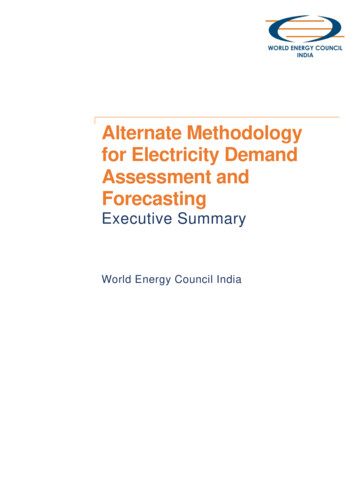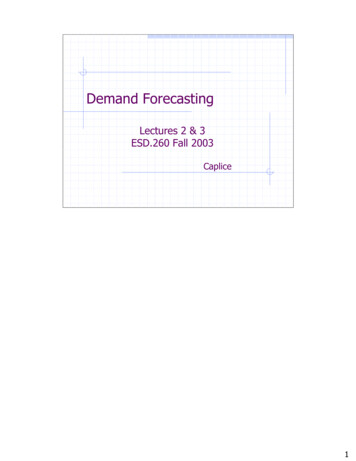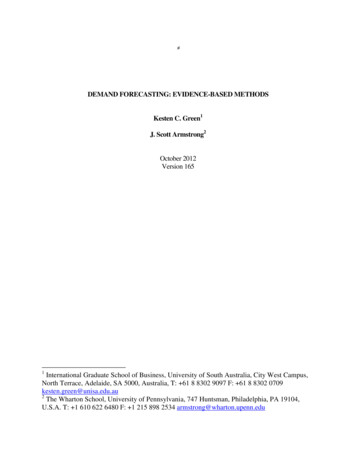
Transcription
DEMAND FORECASTING: EVIDENCE-BASED METHODSKesten C. Green1J. Scott Armstrong2October 2012Version 1651International Graduate School of Business, University of South Australia, City West Campus,North Terrace, Adelaide, SA 5000, Australia, T: 61 8 8302 9097 F: 61 8 8302 0709kesten.green@unisa.edu.au2The Wharton School, University of Pennsylvania, 747 Huntsman, Philadelphia, PA 19104,U.S.A. T: 1 610 622 6480 F: 1 215 898 2534 armstrong@wharton.upenn.edu
2ABSTRACTIn recent decades, much comparative testing has been conducted to determine which forecastingmethods are more effective under given conditions. This evidence-based approach leads to conclusionsthat differ substantially from current practice, . This paper summarizes the primary findings on what todo – and what not to do. When quantitative data are scarce, impose structure by using expert surveys,intentions surveys, judgmental bootstrapping, prediction markets, structured analogies, and simulatedinteraction. When quantitative data are abundant, use extrapolation, quantitative analogies, rule-basedforecasting, and causal methods. Among causal methods, use econometrics when prior knowledge isstrong, data are reliable, and few variables are important. When there are many important variables andextensive knowledge, use index models. Use structured methods to incorporate prior knowledge fromexperiments and experts’ domain knowledge as inputs to causal forecasts. Combine forecasts fromdifferent forecasters and methods. Avoid methods that are complex, that have not been validated, andthat ignore domain knowledge; these include intuition, unstructured meetings, game theory, focusgroups, neural networks, stepwise regression, and data mining.Keywords: checklist, competitor behavior, forecast accuracy, market share, market size, salesforecasting.
3Demand forecasting asks how much can be sold given the situation? The situation includes thebroader economy, social and legal issues, and the nature of sellers, buyers, and the market. Thesituation also includes actions by the firm, its competitors, and interest groups.Demand forecasting knowledge has advanced in the way that science always advances:through accumulation of evidence from experiments that test multiple reasonable hypotheses(Armstrong 2003). Chamberlin was perhaps the first to describe this method, by which he hoped that“the dangers of parental affection for a favorite theory can be circumvented” (1890; p. 754, 1965). Theevidence-based approach led to the agricultural and industrial revolutions that are responsible for ourcurrent prosperity (Kealey 1996), and to the more recent enormous progress in medicine (Gratzer2006). From the evidence of progress in those fields, Chamberlin’s optimistic 1890 conclusion that“ one of the greatest moral reforms that lies immediately before us consists in the general introductioninto social and civic life of the method of multiple working hypotheses” (p. 759) was partly born out.Despite the impressive results in other fields, however, management researchers have largelyignored this evidence-based approach. Few conduct experiments to test multiple reasonablehypotheses. For example, fewer than 3% of the 1,100 empirical articles in a study on marketingpublications involved such tests and many of those few paid little attention to conditions (Armstrong,Brodie, and Parsons 2001).In medicine, a failure to follow evidence-based procedures can be the basis of expensivelawsuits. The idea that practitioners should follow evidence-based procedures is less developed inbusiness and government. Consider, for example, the long obsession with statistical significance testingdespite the evidence that it confuses people and harms their decision-making (Ziliak and McCloskey2008).The Journal of Forecasting was founded in 1981 on a belief that an evidence-based approachwould lead to a more rapid development of the field. The approach met with immediate success.Almost 58% of the empirical papers published in the Journal of Forecasting (1982 to 1985) and theInternational Journal of Forecasting (1985-1987) used the method of multiple reasonable hypotheses.These findings compare favorably with the only 22% of empirical papers in Management Science thatused the method of multiple hypotheses (Armstrong 1979) and the 25% from leading marketingjournals (Armstrong, Brodie, and Parsons 2001). By 1983, the Journal of Forecasting had the secondhighest journal impact factor of all management journals.In the mid-1990s, the forecasting principles project began by summarizing findings fromexperimental studies from all areas of forecasting. The project involved the collaborative efforts of 39leading forecasting researchers from various disciplines, and was supported by 123 expert reviewers.The findings were summarized as principles (condition-action steps). That is, under what conditions isa method effective? One-hundred-and-thirty-nine principles were formulated, They were published inArmstrong (2001, pp 679-732).This article summarizes the substantial progress in demand forecasting by first describingevidence-based methods and then describing principles for selecting the best methods for demandforecasting problems and conditions. It summarizes procedures to improve forecasts by combining,adjusting, and communicating uncertainty. Finally, it describes procedures to ease the implementationof new methods.Forecasting MethodsDemand forecasters can draw upon many methods. These methods can be grouped into 17categories. Twelve rely on judgment, namely unaided judgment, decomposition, expert surveys,
4structured analogies, game theory, judgmental bootstrapping, intentions and expectations surveys,simulated interaction, conjoint analysis, experimentation, prediction markets, and expert systems. Theremaining five methods require quantitative data. They are extrapolation, quantitative analogies, causalmodels, neural nets, and rule-based forecasting. Additional information on the methods is available inPrinciples of Forecasting: A Handbook for Researchers and Practitioners (Armstrong 2001).Methods that rely primarily on judgmentUnaided judgmentExpert’s judgments are convenient for many demand forecasting tasks such as forecasting salesof new products, effects of changes in design, pricing, or advertising, and competitor behavior. Experts’unaided judgments can provide useful forecasts if the experts make many forecasts about similarsituations that are well understood and they receive good feedback that allows them to learn. Mostdemand forecasting tasks are not of this kind, however.When, as is often the case, the situations that are faced by demand forecasters are uncertain andcomplex, experts’ judgments are of little value (Armstrong 1980). Few people are aware of this. Whentold about it most people are sure that the findings do not apply to them. Indeed, companies often payhandsomely for such expert forecasts. Thus it has been labeled the Seer-sucker Theory: “No matterhow much evidence exists that seers do not exist, suckers will pay for the existence of seers”. In arecent test of this theory, subjects were willing to pay for sealed-envelop predictions of the outcome ofthe next toss of a sequence of fair coin tosses. Their willingness to pay and the size of their betsincreased with the number of correct predictions (Powdthavee and Riyanto 2012).In a 20-year experiment on the value of judgmental forecasts, 284 experts made more than82,000 forecasts about complex and uncertain situations over short and long time horizons. Forecastsrelated to, for example, GDP growth and health and education spending for different nations. Theirforecasts turned out to be little more accurate than those made by non-experts, and they were lessaccurate than forecasts from simple models (Tetlock 2005).Experts are also inconsistent in their judgmental forecasts about complex and uncertainsituations. For example, when seven software professionals estimated the development effort requiredfor six software development projects a month or more after having first been asked to do so, theirestimates had a median difference of 50% (Grimstad and Jørgensen 2007). SEEMS OUT OF PLACEHERE Judgmental DecompositionJudgmental decomposition involves dividing a forecasting problem into multiplicative parts.For example, to forecast sales for a brand, a firm might separately forecast total market sales andmarket share, and then multiply those components. Decomposition makes sense when derivingforecasts for the parts is easier than for the whole problem and when different methods are appropriatefor forecasting each part.Forecasts from decomposition are generally more accurate than those obtained using a globalapproach. In particular, decomposition is more accurate when the aggregate forecast is highly uncertainand when large numbers (over one million) are involved. In three studies involving 15 tests, judgmentaldecomposition led to a 42% error reduction when uncertainty about the situation was high (MacGregor2001).
5Expert surveysExperts often have knowledge about how others might behave. To gather this knowledge,, usewritten questions in order to ensure that each question is asked in the same way of all experts. This alsohelps to avoid interviewers’ biases. Avoid revealing expectations that might anchor the experts’forecasts. For example, knowledge of customers’ expectations of 14 projects’ costs had very largeeffects on eight experts’ forecasts—they were eight times higher when customer expectation were highthan when they were low—even when the experts were warned to ignore the expectations due to theirlack of validity (Jørgensen and Sjøberg 2004). Word the questions in different ways to compensate forpossible biases in wording and pre-test all questions. Dillman, Smyth, and Christian (2009) provideadvice on questionnaire design.The Delphi technique provides a useful way to obtain expert forecasts from diverse expertswhile avoiding the disadvantages of traditional group meetings. Delphi is likely to be most effective insituations where relevant knowledge is distributed among experts. For example, decisions regardingwhere to locate a retail outlet would benefit from forecasts obtained from experts on real estate, traffic,retailing, consumers, and on the area to be serviced.To forecast with Delphi, select between five and twenty experts diverse in their knowledge ofthe situation. Ask the experts to provide forecasts and reasons for their forecasts, then provide themwith anonymous summary statistics on the panels’ forecasts and reasons. Repeat the process untilforecasts change little between rounds—two or three rounds are usually sufficient. The median or modeof the experts’ final-round forecasts is the Delphi forecast. Software to help administer the procedure isavailable at forecastingprinciples.com.Delphi forecasts were more accurate than those from traditional meetings in five studies, lessaccurate in one, and equivocal in two (Rowe and Wright 2001). Delphi was more accurate than expertsurveys for 12 of 16 studies, with two ties and two cases in which Delphi was less accurate. Amongthese 24 comparisons, Delphi improved accuracy in 71% and harmed accuracy in 12%.Delphi is attractive to managers because it is easy to understand and the record of the experts’reasoning is informative and it provides credibility. Delphi is relatively cheap because the experts donot meet. Delphi’s advantages over prediction markets include (1) broader applicability, (2) ability toaddress complex questions, (3) ability to maintain confidentiality, (4) avoidance of manipulation, (5)revelation of new knowledge, and (6) avoidance of cascades. Points 5 and 6 refer to the fact thatwhereas the Delphi process requires participants to share their knowledge and reasoning and to respondto that of others, prediction markets’ participants do not exchange qualitative information (Green,Armstrong, and Graefe 2007). In addition, one study found that Delphi was more accurate thanprediction markets. Participants were more favorably disposed toward Delphi (Graefe and Armstrong,2011).Structured analogiesThe structured analogies method is a formal, unbiased process for gathering information aboutsimilar situations and processing that information to make forecasts. The method should not beconfused with the informal use of analogies to justify forecasts obtained by other means.To use structured analogies, prepare a description of the situation for which forecasts arerequired (the target situation) and select experts who are likely to be familiar with analogous situations,preferably from direct experience. Instruct the experts to identify and describe analogous situations, rate
6their similarity to the target situation, and match the outcomes of their analogies with potentialoutcomes of the target situation. Take the outcome of each expert’s top-rated analogy, and use amedian or mode of these as the structured analogies forecast.The research to date on structured analogies is limited but promising. Structured analogies were41% more accurate than unaided judgment in forecasting decisions in eight real conflicts. Conflictsused in the research that are relevant to the wider problem of demand forecasting include unionmanagement disputes, a hostile takeover attempt, and a supply channel negotiation (Green andArmstrong 2007). A procedure akin to structured analogies was used to forecast box office revenue for19 unreleased movies (Lovallo, Clarke, and Camerer 2012). Raters identified analogous movies from adatabase and rated them for similarity. The revenue forecasts from the analogies were adjusted foradvertising expenditure, and if the movie was a sequel. Errors from the structured analogies basedforecasts were less than half those of forecasts from a simple regression model, and those from acomplex one. Structured analogies is easily implemented and understood, and can be adapted fordiverse forecasting problems.Game theoryGame theory involves identifying the incentives that motivate parties and deducing thedecisions they will make. This sounds plausible, and the authors of textbooks and research papersrecommend game theory to make forecasts about conflicts such as those that occur in oligopolymarkets. However, there is no evidence to support this viewpoint. In the only test of forecast validity todate, game theory experts’ forecasts of the decisions that would be made in eight real conflict situationswere no more accurate than students’ unaided judgment forecasts (Green 2002 and 2005). Based on theevidence to date, then, we recommend against the use of game theory for demand forecasting.Judgmental bootstrappingJudgmental bootstrapping estimates a forecasting model from experts’ judgments. The first stepis to ask experts what information they use to make predictions about a class of situations. Then askthem to make predictions for a set of real or hypothetical cases. Hypothetical situations are preferable,because the analyst can design the situations so that the independent variables vary substantially and doso independently of one another. For example, experts, working independently, might forecast first yearsales for proposed new stores using information about proximity of competing stores, size of the localpopulation, and traffic flows. These variables are used in a regression model that is estimated from thedata used by the experts, and where the dependent variable is the expert’s forecast.Judgmental bootstrapping models are most useful for repetitive, complex forecasting problemsfor which data on the dependent variable are not available (e.g. demand for a new product) or where theavailable data on the causal variable do not vary sufficiently to allow the estimation of regressioncoefficients. For example, it was used to estimate demand for advertising space in Time magazine.Once developed, judgmental bootstrapping models can provide forecasts that are less expensive thanthose provided by experts.A meta-analysis found that the judgmental bootstrapping forecasts were more accurate thanthose from unaided judgment in 8 of the 11 comparisons, with two tests showing no difference and oneshowing a small loss (Armstrong 2006) [Any more recent studies? The typical error reduction wasabout 6%. The one failure occurred when the experts relied heavily on an erroneous variable. In other
7words, when judges use a variable that lacks predictive validity—such as the country of origin—consistency is likely to harm accuracy.Intentions and expectations surveysIntentions surveys ask people how they intend to behave in specified situations. The datacollected can be used, for example, to predict how people would respond to major changes in thedesign of a product. A meta-analysis covering 47 comparisons with over 10,000 subjects finds a strongrelationship between people’s intentions and their behavior (Kim and Hunter 1993). Sheeran (2002)reaches the same conclusion with his meta-analysis of ten meta-analyses with data from over 83,000subjects.Surveys can also be used to ask people how they expect they would behave. Expectations differfrom intentions because people know that unintended things happen. For example, if you were askedwhether you intended to visit the dentist in the next six months you might say no. However, you realizethat a problem might arise that would necessitate a visit, so your expectation would be that visiting thedentist in the next six months had a probability greater than zero.To forecast demand using a survey of potential consumers, prepare an accurate andcomprehensive description of the product and conditions of sale. Expectations and intentions can beobtained using probability scales such as 0 ‘No chance, or almost no chance (1 in 100)’ to 10 ‘Certain, or practically certain (99 in 100)’. Evidence-based procedures for selecting samples, obtaininghigh response rates, compensating for non-response bias, and reducing response error are described inDillman, Smyth, and Christian (2009). Response error is often a large component of error. Thisproblem is especially acute when the situation is new to the people responding to the survey, as wouldbe the case for questions about a new product. Intentions data provide unbiased forecasts of demand, sono adjustment is needed for response bias (Wright and MacRae 2007).Intentions and expectations surveys are useful when historical demand data are not available,such as for new product forecasts or for a new market. They are most likely to be useful in cases wheresurvey respondents have had relevant experience. Other conditions favoring the use of surveys ofpotential customers include: (1) the behavior is important to the respondent, (2) the behavior is planned,(3) the respondent is able to fulfill the plan, and (4) the plan is unlikely to change (Morwitz 2001).Focus groups have been proposed to forecasts customers’ behavior. However, there is noevidence to support this approach for demand forecasting, Furthermore, the approach violatesimportant forecasting principles. First, the participants are seldom representative of the population ofinterest. Second, they use small samples. Third, in practice, questions for the participants are often notwell structured or well tested. Fourth, in summarizing the responses of focus group participants,subjectivity and bias are difficult to avoid. Fifth, and most important, the responses of participants areinfluenced by the presence and expressed opinions of others in the group.Simulated interactionSimulated interaction is a form of role-playing that can be used to forecast decisions by peoplewho are interacting. For example, a manager might want to know how best to secure an exclusivedistribution arrangement with a major supplier, how a competitor would respond to a proposed sale, orhow important customers would respond to possible changes in the design of a product.Simulated interactions can be conducted inexpensively by using students to play the roles.Describe the main protagonists’ roles, prepare a brief description of the situation, and list possible
8decisions. Participants adopt a role, then read the situation description. They engage in realisticinteractions with the other role players, staying in their roles until they reach a decision. Simulationstypically last between 30 and 60 minutes.Relative to the usual forecasting method of unaided expert judgment, simulated interactionreduced forecast errors by 57% for eight conflict situations (Green 2005). These were the samesituations as for structured analogies (described above), where the error reduction was 41%If the simulated interaction method seems onerous, you might think that following the commonadvice to put yourself in the other person’s shoes would help a clever person such as yourself to predictdecisions. For example, Secretary of Defense Robert McNamara said that if he had done this during theVietnam War, he would have made better decisions.3 He was wrong: A test of “role thinking” by theauthors found no improvement in the accuracy of the forecasts (Green and Armstrong 2011).Apparently, thinking through the interactions of parties with divergent roles in a complex situation istoo difficult; active role-playing between parties is necessary to represent such situations with sufficientrealism to derive useful forecastsConjoint AnalysisConjoint analysis can be used to examine how demand varies as important features of a productare varied. Potential customers are asked to make selections from a set of offers such as 20 differentdesigns of a product. For example, various features of a tablet computer such as price, weight,dimensions, software features, communications options, battery life, and screen clarity could be variedsubstantially while ensuring that the variations in features do not correlate with one another. Thepotential customer chooses from among various offerings. The resulting data can be analyzed byregressing respondents’ choices against the product features.Conjoint analysis is based on sound principles, such as using experimental design and solicitingindependent intentions from a representative sample of potential customers. So it should be useful.However, despite a large academic literature and widespread use by industry, experimentalcomparisons of conjoint-analysis with other reasonable methods are scarce (Wittink and Bergestuen2001). In an experiment involving 518 subjects making purchase decisions about chocolate bars,conjoint analysis led to forecasts of willingness to pay that were between 70% and 180% higher thanthose that were obtained using a lottery that was designed to elicit true willingness to pay figures(Sichtmann, Wilken, Diamantopoulos 2011). In this context, users of conjoint analysis should considerconducting their own experiments to compare the accuracy of the conjoint analysis forecasts with thosefrom methods.ExperimentationExperimentation is widely used and is the most realistic method for forecasting the effects ofalternative courses of action. Experiments can be used to examine how people respond to such thingsas a change in the design of a product or to changes in the marketing of a product. For example, howwould people respond to changes in the automatic answering systems used for telephone inquiries?Trials could be conducted in some regions but not others. Alternatively, different subjects might beexposed to different telephone systems in a laboratory experiment.3From the documentary film, “Fog of War.”
9Laboratory experiments allow greater control, testing of conditions is easier, costs are usuallylower, and they avoid revealing sensitive information to competitors. A lab experiment might involvetesting consumers’ relative preferences by presenting a product in different packaging, and recordingtheir purchases in a mock retail environment. A field experiment might involve, for example, chargingdifferent prices in different geographical markets to estimate the effects on total revenue. Researcherssometimes argue over the relative merits of laboratory and field experiments. An analysis ofexperiments in organizational behavior found that the two approaches yielded similar findings (Locke1986).Prediction marketsPrediction markets—which are also known as betting markets, information markets, andfutures markets—have been used to make forecasts since the 1800s. Prediction markets can be createdto predict such things as the proportion of U.S. households with three or more vehicles by the end of2015. Confidential markets can be established within firms to motivate employees to reveal theirknowledge, as forecasts, by buying and selling contracts that reward accuracy. Forecasting first yearsales of a new product is one possible application. Prediction markets are likely to be superior tounstructured meetings because they efficiently aggregate the dispersed information of anonymous selfselected experts. However, this applies to the use of any structured approach. For example the secondauthor was invited to a meeting at a consumer products company in Thailand in which a newadvertising campaign was being proposed. The company’s official forecast was for a substantialincrease in sales. The author asked the 20 managers in the meeting for their anonymous forecasts alongwith 95% confidence intervals. None of the mangers forecast an appreciable increase in sales. Theofficial forecast was greater than the 95% confidence intervals of all of the mangers.Some unpublished studies suggest that prediction markets can produce accurate sales forecasts.Despite the promise, the average improvement in accuracy across eight published comparisons in thefield of business forecasting—relative to forecasts from, variously, naïve models, econometric models,individual judgment, and statistical groups—is mixed. While the error reductions range from 28%(relative to naïve models) to -29% (relative to average judgmental forecasts), the comparisons wereinsufficient to provide guidance on the conditions that favor prediction markets (Graefe 2011).Nevertheless, without strong findings to the contrary and with good reasons to expect someimprovement, when knowledge is dispersed and a sufficient number of motivated participants aretrading, assume that prediction markets will improve accuracy relative to unaided group forecasts.Expert systemsExpert systems are codifications of the rules experts use to make forecasts for a specific productor situation. An expert system should be simple, clear, and complete. To identify the rules, recordexperts’ descriptions of their thinking as they make forecasts. Use empirical estimates of relationshipsfrom econometric studies and experiments when available in order to ensure that the rules are sound.Conjoint analysis, and bootstrapping can also provide useful information.Expert system forecasts were more accurate than those from unaided judgment in a review of15 comparisons (Collopy, Adya and Armstrong 2001). Two of the studies, on gas and mail ordercatalogue sales, involved forecasting demand. The expert systems error reductions were 10% and 5%respectively in comparison with unaided judgment. Given the small effects, limited evidence, and the
10complexity of experts systems, it would be premature to recommend expert systems for demandforecasting.Methods requiring quantitative dataExtrapolationExtrapolation methods require historical data only on the variable to be forecast. They areappropriate when little is known about the factors affecting a variable to be forecast. Statisticalextrapolations are cost effective when many forecasts are needed. For example, some firms needfrequent forecasts of demand for each of hundreds of inventory items.Perhaps the most widely used extrapolation method, with the possible exception of using lastyear’s value, is exponential smoothing. Exponential smoothing is sensible in that recent data areweighted more heavily and, as a type of moving average, the procedure smoothes out short-termfluctuations. Exponential smoothing is understandable, inexpensive, and relatively accurate. Gardner(2006) provides a review of the state-of-the-art on exponential smoothing.When extrapolation procedures do not use information about causal factors, uncertainty can behigh, especially about the long-term. The proper way to deal with uncertainty is to be conservative. Fortime series, conservatism requires that estimates of trend be damped toward no change: The greater theuncertainty about the situation, the greater the damping that is needed. Procedures are available to dampthe trend and some software packages allow for damping. A review of ten comparisons found that, onaverage, damping reduced forecast error by almost 5% when used with exponential smoothing(Armstrong 2006). In addition, damping reduces the risk of large errors and can moderate the effects ofrecessions. Avoid software that does not provide proper procedures for damping.When extrapolating data of greater than annual frequency, remove the effects of seasonalinfluences first. Seasonality adjustments lead to substantial gains in accuracy, as was shown in alarge-scale study of time-series forecasting: In forecasts over an 18-month horizon for 68 monthlyeconomic series, they reduced forecast errors by 23 percent (Makridakis, et al. 1984, Table 14).Because seasonal factors are estimated, rather than known, they should be damped. Miller andWilliams (2003, 2004) provide procedures for damping seasonal factors. Their software for calculatingdamped seasonal adjustment factors is available at forecastingprinciples.com. When they applied theprocedures to the 1,428 monthly time series from the M3-Competition, forecast accuracy improved for68% of the series. In another study, damped seasonal estimates were obtained by averaging estimatesfor a given series with seasonal factors estimated for related products. This damping reduced forecasterror by
models, neural nets, and rule-based forecasting. Additional information on the methods is available in Principles of Forecasting: A Handbook for Researchers and Practitioners (Armstrong 2001). Methods that rely primarily on judgment Unaided judgment Expert's judgments are convenient for many demand forecasting tasks such as forecasting sales
